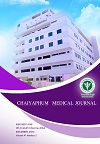Attention-Deficit Hyperactive Disorder in Children, aged 5-14 years old Bamnetnarong Hospital, Chaiyaphum province.
Keywords:
ADHD, Factors, ChildrenAbstract
Background: Attention-Deficit Hyperactive Disorder (ADHD) is a common psychiatric disorder in children characterized by three clusters of symptoms: inattention, hyperactivity and impulsivity.
Objective: To study of general data, treatment outcomes and factors related to the dose of Methylphrenidate used in ADHD children at Bamnetnarong hospital, Chaiyaphum province.
Methods: This retro-prospective descriptive study examined 219 ADHD children at Bamnetnarong hospital, Chaiyaphum province, between 1 January 2018 and 31 July 2021, aged 5-14. Inclusion criteria for ADHD children were diagnosed using DSM IV-TR criteria. Exclusion criteria for children with ADHD were not followed up until the date of data collection. Data analysis presents the average, percentage, proportion and Fisher’s Exact Test.
Results: The sample was selected from 134 ADHD children, most common in boys (72.4 percentage). The ratio of boys to girls was about 2.6:1. The average age was 8 years old (SD=1.84). 61.9 percent of ADHD children were raised by there parents. The combined type was the most common (82.8 percentage). The most common comorbidity disorder were Oppositional defiant disorder (11.9 percentage). The most common dose of Methylphrenidate used was 20 mg per day (64.9 percentage). Nausea, vomiting and weight loss were the most common side effects (17.2 percentage). The statistic significant factors affecting ADHD were the doses of Methylphrenidate used in boys, which were higher than girls (p-value<0.05) and the doses of Methylphrenidate used in combined type of ADHD, which were higher than other types of ADHD (p-value<0.05).
Conclusions: ADHD children at Bamnetnarong hospital, Chaiyaphum province, most common in boys, 8 years old, stayed with parents, combined type and comorbidity disorder were Oppositional defiant disorder. Statistic significant factors effect to ADHD were dose of Methylphrenidate used in boys and combine type ADHD, which were higher than girls and other types ADHD.
References
Boon-yasidhi V. Attention deficit hyperactivity disorder: diagnosis and management. J Psychiatr Assoc Thailand, 2012;57(4):373-86.
American Psychiatric Association. Diagnostic and statistical Manual of Mental disorders, 4thedition Text rev. (DSM-IV-TR). Washington, DC:American Psychiatric Association, 2000.
ณัทธร พิทยรัตน์เสถียร, ธันวรุจน์ บูรณะสุขสกุล, ดุษฎี จึงศิรกุลวิทย์ และทรงภูมิ เบญญากร. คุณสมบัติของแบบคัดกรองโรคสมาธิสั้นชื่อ Swanson, Nolan, and Pelham IV Scale (SNAP-IV) และ Strengths and Difficulties Questionnaire ส่วนที่เกี่ยวข้องกับ พฤติกรรมอยู่ไม่นิ่ง/สมาธิสั้น (SDQ-ADHD) ฉบับภาษาไทย. วารสารสมาคมจิตแพทย์แห่งประเทศไทย, 2557;59(2):97-110.
Cunningham NR, Jensen P. Attention-defit/hyperactivity disorder. In: Kliegman RM, Stanton BF, Shor NF, St. Geme III JW, Behrman RE, editors. Nelson textbook of pediatrics. 19th ed. Philadelphia: Elsevier Suanders, 2011:108-12.
จิรนันท์ วีรกุล. โรคสมาธิสั้นและภาวะอยู่ไม่นิ่งในเด็ก. พุทธชินราชเวชสาร, 2557;31(1):65-75.
Pliszka SR. Pattern of psychiatric comorbidity with attention deficit/heperactivity disorder. Child Adolesc Psychiate Clin N AM, 2009;9:520-40.
ทวีศิลป์ วิษณุโยธิน, พรทิพย์ วชิรดิลก, ธันวรุจน์ บูรณสุขสกุล, โชษิตา ภาวสุทธิไพศิฐ และพัชรินทร์ อรุณเรือง. ความชุกโรคสมาธิสั้นในประเทศไทย. วารสารสุขภาพจิตแห่งประเทศไทย, 2556;21(2):66-75.
พิสมัย พงศาธิรัตน์, พรทิพย์ วชิรดิลก. ปัจจัยที่สัมพันธ์กับโรคสมาธิสั้นในนักเรียนชั้นประถมศึกษา. วารสารการพยาบาลจิตเวชและสุขภาพจิต, 2556;27(1):108-20.
กันยา พาณิชย์ศิริ, เบญจพร ตันตสูติ. การติดสื่อสังคมออนไลน์และภาวะสมาธิสั้นของนักเรียนชั้นมัธยมศึกษาตอนปลายในเขตกรุงเทพมหานคร. วารสารสมาคมจิตแพทย์แห่งประเทศไทย, 2559;61(3):191-204.
วรานุช ปิติพัฒน์, บรรณาธิการ. ระเบียบวิธีวิจัยทางทันตแพทยศาสตร์. พิมพ์ครั้งที่ 2. ขอนแก่น: โรงพิมพ์มหาวิทยาลัยขอนแก่น, 2557.
Wacharasindhu A, Panyayong B. Psychiatric Disorder in Thai School-Aged Children: I Prevelence. J Med Assoc Thai, 2002;85(suppl1):S125-36.
Trangkasombat U. Clinical Characteristics of ADHD in Thai Children. J Med Assoc Thai, 2008;91(12):1894-9.
Boonsub S, Kritchaporn C, Nadcha S, Soraya C, Chawengsak K, Wetawit S, et al. Prevalence and Associated Factors of Attention Deficit Hyperactivity Disorder (ADHD) in a Rural Community, Central Thailand: A Mixed Methods Study. Global Journal of Health Science, 2018;10(3):60-9.
MTA Cooperation Group. 14 month randomized clinical trial of treatment strategies for children with attention deficit hyperactivity disorder. Arch Gen Psychiatry, 1999;56:1073-86.
Taylor E, Dopfner M, Sergeant J, Asherson P, Banaschewski T, Buitelaar J, et al. European clinical guidelines for hyperkinetic disorder-first update. Eur Child Adolesc Psychiatry, 2004;13 (Suppl1):7-30.
Greenhill LL, Pliszka S, Dulcan MK, Bernet W, Arnold V, Beitchman J. Practice parameter for the use of stimulant medications in the treatment of children, adolescent, and adults. J Am Acad Child Adolesc Psychiatry, 2002;41(2 Suppl):26S-49S.
Downloads
Published
Versions
- 2021-12-30 (2)
- 2021-12-29 (1)
Issue
Section
License
Copyright (c) 2021 Chaiyaphum Medical Journal : ชัยภูมิเวชสาร

This work is licensed under a Creative Commons Attribution-NonCommercial-NoDerivatives 4.0 International License.





